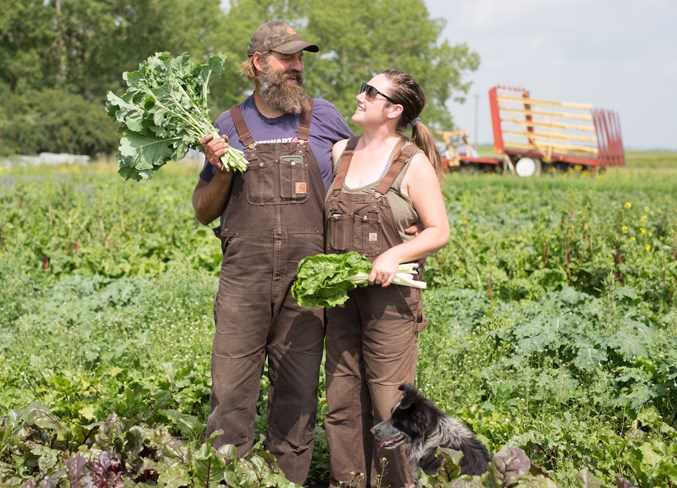On a farm near Carstairs, a husband and wife team take a dynamic approach to how they produce food – a biodynamic approach, that is.
Blue Mountain Biodynamic Farm, owned and operated by Kris and Tamara Vester, is run to be as self-sustaining as possible.
“We’re trying to grow food as well as we can, trying to make a living and trying to grow tasty, fresh food for people, and trying to do it ethically and sustainably with a real focus on the ecology of production,” said Kris.
To do so, they farm the land that has been in Kris’s family since 1977. On their quarter section near Carstairs they produce pork, have chickens for eggs and meat, and grow grain, vegetables and hay.
“It’s entirely focused on growing food for local markets,” Kris said. “You can’t make money growing commodities on a quarter section of land.”
In addition to selling at farmers markets and to restaurants, there has been a community supported agriculture box (CSA) available through the farm since 1998, when Kris returned to the farm after travelling and studying. Signing up for a CSA means getting a share of the harvest, usually weekly, throughout the season.
When Kris returned to the farm and began working with his father (who retired in 2010), they started transitioning the farm to organic certification and focusing on local markets.
“Philosophically I’m much more oriented towards building relationships with local eaters and local community,” Kris said. That includes the Calgary area, which offers a bigger market than the nearby smaller communities like Carstairs or Didsbury.
“I’m not really interested in being a purely anonymous person. I think there’s great value … in a relationships built between producers and eaters of food,” he said.
In Alberta, the Vesters were early adopters of the CSA model. Kris said the idea came out of Europe a few decades ago, but in 1998 his family farm was one of the first few Albertan farms to try it out.
About five or six years ago, there was a big boom of producers offering a community-supported agriculture share. That’s lessened somewhat, Kris said, as some producers realized how much work it can be and decided to not continue with the model.
“It’s still a tremendous amount of work to make a living,” he said.
The CSA model offers a risk-sharing arrangement. The customers who opt to sign up for the season, expecting a bountiful box of produce and more from the farm every week, might learn first-hand about the challenges farmers face and get less than expected some weeks – or even nothing.
For instance, in 2009, hail destroyed the crops completely.
“Our supporters … they put on a fundraiser for us so we could actually survive that year, which otherwise we would have,” Kris said, adding that smaller diverse operations like theirs don’t easily qualify for hail insurance programs.
Having the CSA in place helps farmers manage their risk, while offering a chance for what Kris calls “reciprocal education” between the producers and the eaters. The consumers learn about farming and what it takes to produce their food, and the producers learn about their customers’ preferences and how they feed their families.
“It’s a really important relationship with those families,” he said.
Blue Mountain is dual-certified for organic growing and biodynamic agriculture. The biodynamics certification was received in 2010, and after letting the organic certification lapse for a few years, the farm is now certified for both.
Organic growing and biodynamics growing are very similar in terms of the restrictions placed on the farmer, Kris said. For example, in either there are no synthetic fertilizers, herbicides or pesticides allowed.
But biodynamics further focuses on creating an independent, self-sustaining farm organism or unit. So while you can bring in organic fertilizer from anywhere to keep your certification as an organic grower, to be biodynamic that fertilizer would ideally come from your own farm.
“There’s more of an emphasis on the cycling of nutrients within the farm organism,” Kris said.
“You’re trying to grow your own fertility, you always have livestock involved in the system as well,” he said, noting it’s important for compost.
“‘It’s really about producing fertility on the farm and about diversity,” he adds, noting most biodynamics operations have a variety of crops and livestock, like Blue Mountain.
The theory even pays attention to moon cycles, for instance. Kris noted many animals, including humans, have a lunar cycle of about 28 days – that same energy impacts plants, he said.
“That’s ancient, ancient knowledge,” he said.
The biodynamics farming approach “just makes sense to me,” Kris said.
“For me I’m trying to create something that’s truly sustainable, and that means working within the limitations of our local resources,” he said.
The Vesters even leave some land unused, trying to provide a space for birds and other wildlife.
Even with all the challenges inherent in farming, Kris loves his work.
“There is nothing either of us would rather do,” he said of him and Tamara. They are their own bosses – the farm has five full-time employees during the summer and one full-time year round, plus the Vesters – they get to work outdoors and they build great relationships in the community.
“It’s really, really satisfying,” he said.



